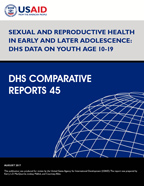- PUBLICATIONS
- JOURNAL ARTICLES
- ORDER PUBLICATIONS
Publications Summary
Sexual and Reproductive Health in Early and Later Adolescence: DHS Data on Youth Age 10-19 (English)
- Document Type
- Comparative Reports
- Publication Topic(s)
- Domestic Violence, Family Planning, Fertility and Fertility Preferences, Gender, Youth
- Language
- English
- Recommended Citation
- MacQuarrie, Kerry L.D., Lindsay Mallick, and Courtney Allen. 2017. Sexual and Reproductive Health in Early and Later Adolescence: DHS Data on Youth Age 10-19. DHS Comparative Reports No. 45. Rockville, Maryland, USA: ICF.
- Download Citation
- RIS format / Text format / Endnote format
- Publication Date
- August 2017
- Publication ID
- CR45
Download
 Sexual and Reproductive Health in Early and Later Adolescence: DHS Data on Youth Age 10-19 (PDF, 5579K)
Sexual and Reproductive Health in Early and Later Adolescence: DHS Data on Youth Age 10-19 (PDF, 5579K)
